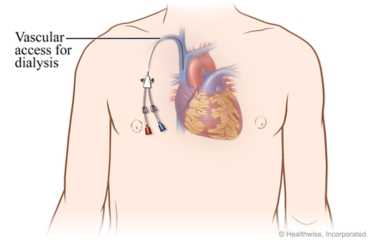Short-term Catheter for Hemodialysis: Care Instructions
Overview

To start hemodialysis (also called dialysis) right away, your doctor will insert a soft plastic tube into a
vein. This tube will carry your blood to the dialysis machine. The tube is called a central vascular access
device (CVAD), or a central line. It will be your vascular access until your permanent access is ready to use.
If you have a kidney injury that can be healed, you may need dialysis only for a short time. But some people
will need to have long-term dialysis. This includes people with chronic kidney disease.
If you need long-term dialysis, it can take weeks or months for a permanent vascular access to be ready to
use. You can use a CVAD until a permanent access site is ready.
It will be placed in a large vein, usually in your chest, neck or arm. Or it may be in your groin. A few
stitches will hold it in place.
By learning how to care for your access, you will help avoid problems and get the best results from your
dialysis treatments.
Follow-up care is a key part of your treatment and safety. Be sure to make and go to all
appointments, and call your doctor if you are having problems. It's also a good idea to know your test results
and keep a list of the medicines you take.
How can you care for yourself at home?
-
Make sure the catheter is secured to your body and and isn't pulling.
-
Avoid clothes that rub or pull on your catheter.
-
Never use scissors or other sharp objects around your catheter.
-
Don't bend or crimp your catheter.
-
Ask your doctor or dialysis nurse when you can take a bath or shower. You may be able to do these things
after the site heals or if you cover the site with a waterproof bandage.
-
You can stay active while the catheter is in. But talk to your doctor about the kind of activities you
want to do.
-
Review emergency instructions with your dialysis team so you know what to do if your catheter comes out.
-
Keep your bandage and exit site dry and clean. Change a dirty or bloody bandage. Check the site every day
for signs of infection.
-
Always wash your hands before you touch your catheter.
-
Keep the end of the catheter covered when it's not in use.
-
Wear a mask during your dialysis treatments. It can keep you from breathing germs onto your catheter.
When should you call for help?
 Call 911
anytime you think you may need emergency care. For example, call if:
Call 911
anytime you think you may need emergency care. For example, call if:
Call your doctor now or seek immediate medical care if:
Watch closely for changes in your health, and be sure to contact your doctor if you have
any problems.
Current as of: October 11, 2023
Content Version: 14.0
Care instructions adapted under license by your
healthcare professional. If you have questions about a medical condition or this instruction, always ask
your healthcare professional. Healthwise, Incorporated disclaims any warranty or liability for your use of
this information.